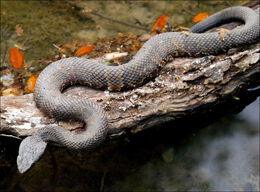
Cottonmouth snakes, otherwise known as water moccasins, are a medium sized snake, often growing to be four feet in length, and I've even seen up to five feet. They are generally a dark shade of brown or a dull black and will occasionally have lighter banding visible on their sides. The younger snakes have lighter color and more distinct patterns. The body of this snake is considered to be bulky with a distinct neck going into a relatively large, triangular head. The tail also tapers off quickly at the end of the body, from fat to thin. Like most pit vipers, the cottonmouth has pupils which are shaped like slits. This snake is considered very venomous, producing a toxin which prohibits the ability of the blood to clot while destroying tissue on a cellular level. Any area that comes in contact with water moccasin venom will begin to hemorrhage, giving the name "cytotoxic" (similar to ‘hemotoxic’ ) to this type of poison.
Habitat and Behavior[]
Cottonmouths are semi-aquatic snakes, meaning they spend the majority of their lives in the water. They are found predominately in the southern part of the United States, including all of Florida and up the coast, and in the mid south, up the Mississippi River system. living in and near small and large bodies of water. Water moccasins are often mistaken for non-venomous brown water snakes, one of the reasons they are particularly lethal.
Like all pit vipers, the cottonmouth snake has two heat sensing pits located between the eyes and the nostrils. These pits allow the snake to pinpoint live prey and to strike without the need of a visual. This hunting adaptation is particularly useful after dark when most animals’ bodies are warmer than the air around them. Hunting, and most of the snake’s activities, takes place during the night. Because of this, and because the water moccasin spends much of its time in the water, the snake spends a considerable amount of time basking in the sun. The cool water saps the snake’s body temperature much faster than land bound serpents. Basking is an efficient way to regulate body temperature.
Female snakes will give birth to litters of up to ten live snakes after the spring mating season. The babies are born from eggs which are hatched inside of the female snake and are not developed in a uterus like mammalian animals. Like almost all other reptiles, baby snakes are on their own as soon as they are born.
Diet[]
The cottonmouth eats a large variety of wildlife. Frogs, salamanders, fish, other snakes, birds, rabbits, squirrels, chipmunks, and a host of other small creatures are all fair game to the snake. When a prey animal is detected, the cottonmouth will strike, holding its victim for a moment to allow the full injection of venom to take place. Once that happens, the snake immediately releases its prey to limit the amount of retaliation, especially from strong mammals. If the prey escapes and runs away, the snake will track it by smell and consume it once it is dead.
Like the copperhead snake, young cottonmouths will use their tails to lure amphibians to them. Once the unsuspecting frog or salamander is close enough, the baby cottonmouth snake will strike. This method of attracting prey is called ‘caudal luring’.
Other Facts[]
- The cottonmouth snake gets its name from the defense position the snake takes when it feels threatened. When antagonized, the cottonmouth will coil up and display its fangs, revealing the pale white skin inside of the mouth.
- Cottonmouths are very buoyant, with most of their bodies visible when they swim. Other, non-venomous water snakes will swim with their bodies completely submerged except for the head.
- These snakes can and will attack underwater.
- During the winter, cottonmouths will hibernate, sometimes sharing dens with other venomous snakes. In consistently warm climates, the cottonmouth has been known to not hibernate at all.
- Commonly thought of as an aggressive snake, the cottonmouth’s reputation has been greatly exaggerated. If given the chance, the snake will flee before it will pose to strike.
- The origins of the title ‘water moccasin’ are unknown, though it is speculated that name comes from the leather-like coloration of the snakes or the silent movement akin to that of moccasin wearing Native Americans.